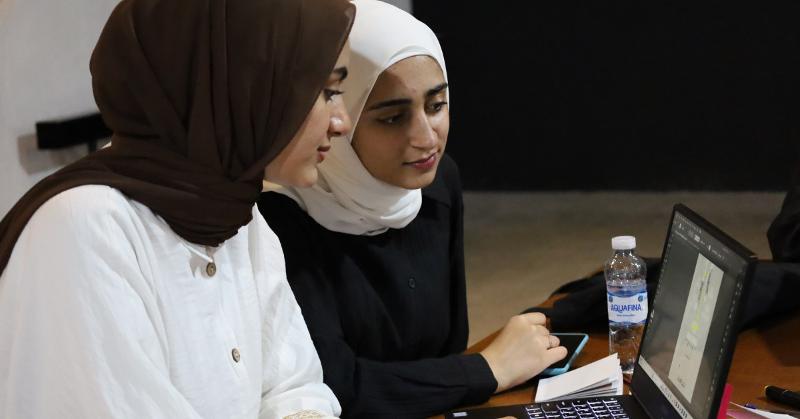At the Al Balad Theater, a group of aspiring digital artists came together for a unique journey that would not only test their creative boundaries but also challenge their understanding of human rights. Join Layan Abu Atia and Aram as they explore the connection between art and human rights, showcasing the transformative power of art in advocating for a just and equitable society.
Exploring the Connection Between Art and Human Rights
Discover how Layan Abu Atia and Aram use their artistic talents to shed light on human rights issues.
Art has long been recognized as a powerful tool for self-expression and social commentary. Layan Abu Atia and Aram, two talented digital artists, have taken this concept a step further by using their artistic abilities to advocate for human rights. Through their thought-provoking artwork, they explore the intricate connection between art and human rights, challenging societal norms and sparking important conversations.
By delving into themes such as free expression, critical thinking, and education, Layan and Aram aim to highlight the fundamental principles of the Universal Declaration of Human Rights. Their art serves as a catalyst for change, encouraging viewers to reflect on the importance of these rights in creating a just and equitable society.
Inking Brains: The Power of Free Expression
Discover Layan Abu Atia and Leeyan Ghonajoq's project that explores the right to free expression and quality education.
Layan Abu Atia and her partner, Leeyan Ghonajoq, embarked on a project titled 'Inking Brains' during the workshop. This project aimed to delve into the right to free expression and its connection to quality education. Through their artwork, they sought to emphasize the role of communication, media, and education in shaping our perceptions of the world.
Their art beautifully represented the essence of free expression through the use of primary colors - red, yellow, and blue. Each color symbolized the vibrant nature of expressing oneself freely. By showcasing the brain as the starting point for expression and thought, Layan and Leeyan's artwork emphasized the importance of nurturing these rights to ensure a society where free expression thrives.
No Rights: The Struggle for Freedom of Expression
Explore Aram's powerful artwork that depicts the suppression of the right to freedom of expression.
Aram's project, titled 'No Rights,' delves into the complexities of Article 19 of the Universal Declaration of Human Rights - the right to freedom of expression. Through her artwork, she portrays the harsh reality faced by individuals in societies where this fundamental right is denied or suppressed.
In her creation, Aram depicts a rational human being bound like an infant with a restricting blanket, symbolizing the suppression of expression. As the individual matures, their movement becomes further constricted by iron sheets and sharp wires, representing the growing obstacles to voicing their opinions. The adhesive on their ears, mouth, and eyes serves as a poignant representation of the stifling effect on their thoughts.
'No Rights' captures the heartbreaking journey of individuals who, over time, begin to believe that having rights is unnatural. The adhesive becomes ingrained in their skin, a painful reminder of the struggle to express themselves freely.
The Power of Art in Advocating for Human Rights
Witness the transformative impact of art in raising awareness and inspiring change.
The 4-day Art Lab Workshop at Al Balad Theater provided these artists with a platform to express their thoughts, concerns, and hopes for human rights through the medium of digital art. Layan Abu Atia, Aram, and their fellow participants showcased their immense talent and raised important questions about the state of human rights in Jordan and beyond.
Through their artistic endeavors, these artists expanded the scope of discussion and elevated the dialogue about crucial human rights issues. Their work serves as a testament to the transformative power of art in the pursuit of social justice, bridging the gap between legal frameworks and the lived experiences of individuals.
Art has the ability to provoke thought, inspire change, and ignite a collective consciousness about human rights. Layan, Aram, and their fellow participants have shown us that the right to free expression is a fundamental cornerstone of a just and equitable society, and through their art, they are making a meaningful impact on society.
Conclusion
The journey of Layan Abu Atia, Aram, and their fellow participants at the Art Lab Workshop at Al Balad Theater showcased the transformative power of art in advocating for human rights. Through their thought-provoking artwork, they shed light on the importance of free expression, critical thinking, and quality education in creating a just and equitable society.
Art has the ability to provoke thought, inspire change, and ignite a collective consciousness about human rights. Layan, Aram, and their fellow participants have shown us that art can bridge the gap between legal frameworks and the lived experiences of individuals, expanding the scope of discussion and elevating the dialogue about crucial human rights issues.
As we reflect on their artistic endeavors, let us remember that the right to free expression is a fundamental cornerstone of a just and equitable society. Through their art, Layan, Aram, and their fellow participants are making a meaningful impact on society, reminding us all of the importance of upholding and protecting human rights.

